
Layer 2 Payments in 2025 – Stablecoins, Base’s Rise, and ETH’s Decline

Layer 2 networks were built to make Ethereum more scalable. But in the world of payments, they are evolving into something else entirely.
Instead of saving ETH from high gas fees, they’re becoming the highways for stablecoins — the assets people increasingly trust and use in everyday commerce.
CoinGate’s data from 2023–2025 tells that story clearly. If we look closely at the activity on Polygon and Arbitrum, the first movers, and newcomers like Base and Optimism, a pattern emerges: stablecoins are climbing, ETH is fading, and the U.S. alongside emerging markets are driving much of the demand.
Polygon & Arbitrum: Veterans on Diverging Paths
Polygon
When we integrated Polygon in early 2023, it quickly moved up the ranks, from the 11th to the 7th most used blockchain for payments at CoinGate.
Growth continued steadily: in 2024 we processed 135% more transactions on Polygon compared to the year before, and another 16.5% year-over-year growth followed in 2025.
July 2025 even marked Polygon’s busiest month yet, thanks largely to surging USDC usage, which now accounts for nearly a third of all payments on the network.
Polygon’s payment growth has been significant:
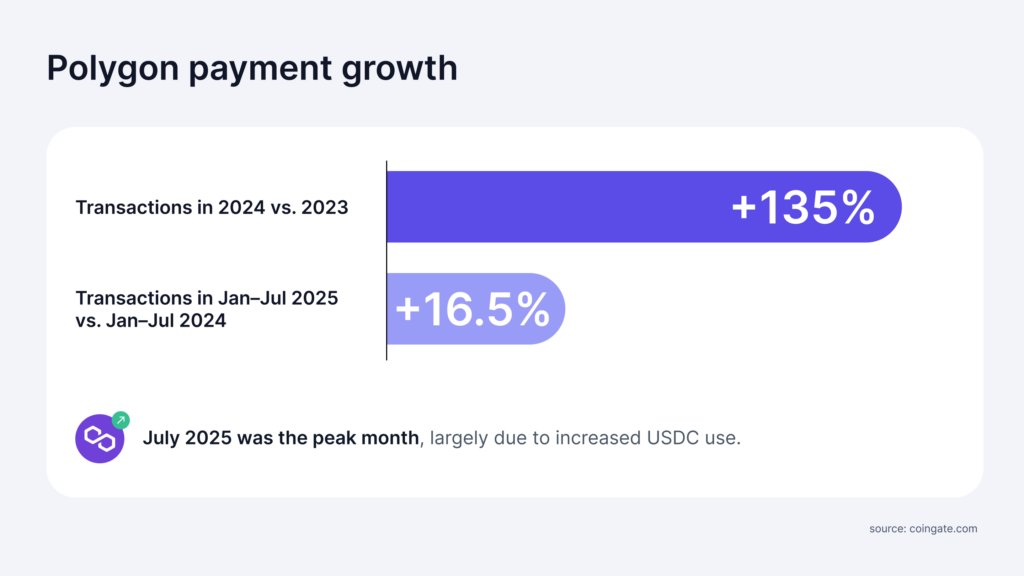
Its currency mix evolved substantially in 2025:
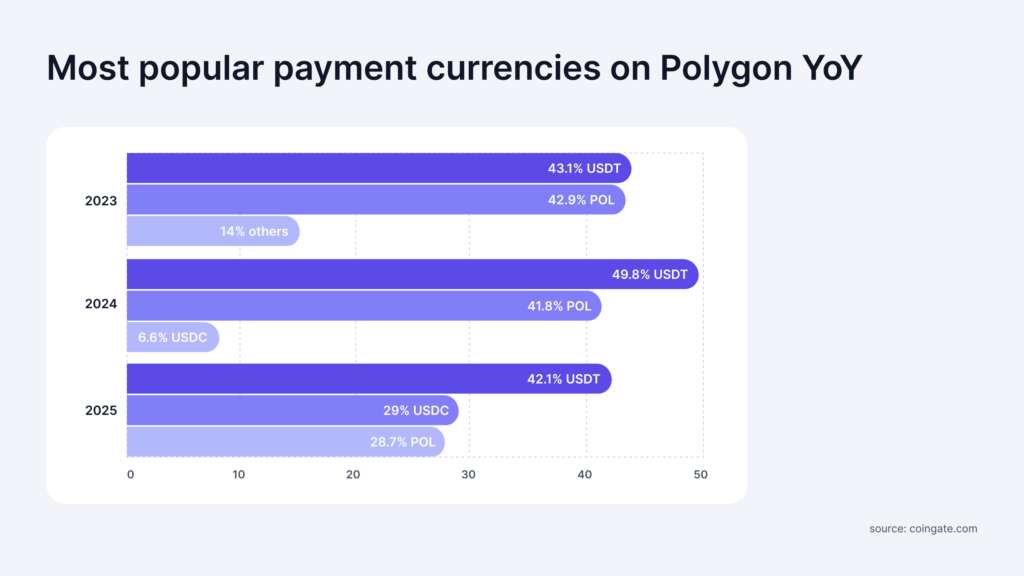
Top markets using Polygon for payments in 2025:

Arbitrum
Arbitrum, launched later that same year, followed a very different path. While Polygon grew steadily, Arbitrum exploded from the 12th most used blockchain but quickly surged to 8th place.
Payments on the network increased by more than 565% in 2024 compared to 2023, and activity nearly doubled again this year. But the bigger story lies in how people use it: ETH, which made up more than half of Arbitrum payments in 2023, has shrunk to just 23% in 2025.
The rest has been taken over by USDT and USDC, making Arbitrum one of the clearest examples of stablecoin dominance.
Arbitrum’s growth has been impressive:
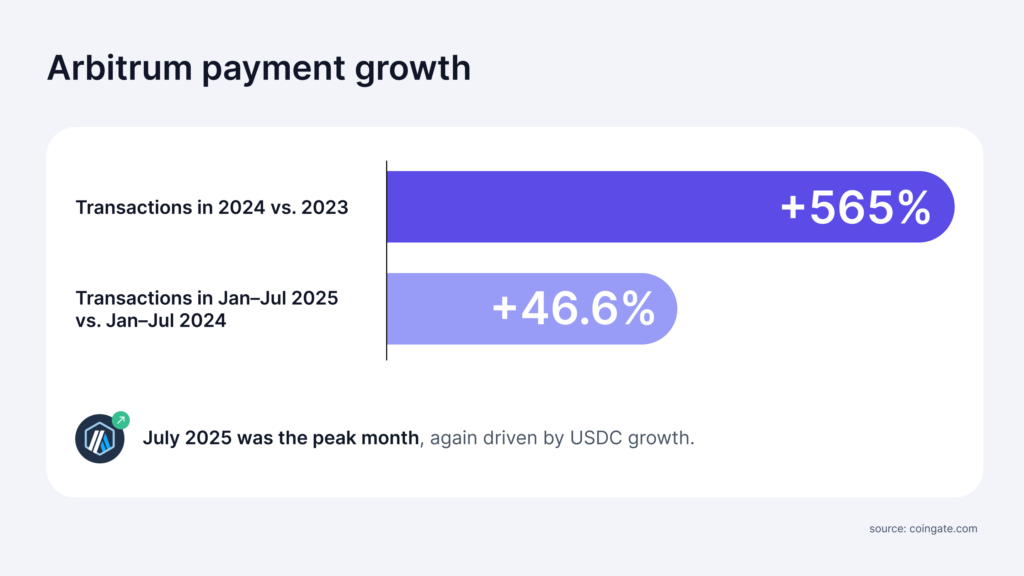
Its currency evolution highlights the broader L2 trend:
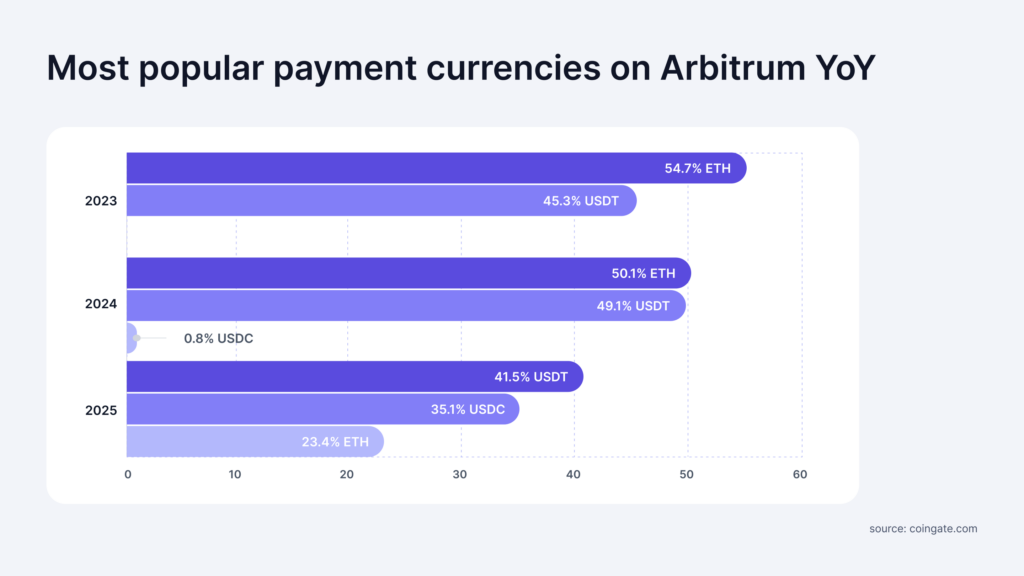
In just two years, ETH payments on Arbitrum fell by more than half.
Top markets using Arbitrum for payments in 2025:
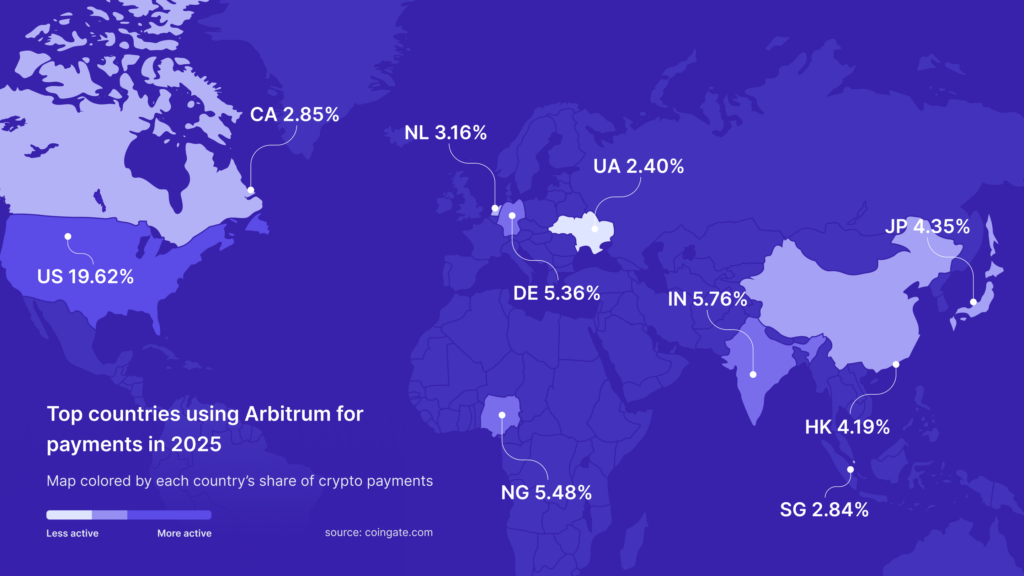
Today, Polygon and Arbitrum sit neck and neck, usually alternating between the seventh and eighth most-used blockchains on CoinGate. Their growth patterns couldn’t be more different — Polygon steady and balanced, Arbitrum fast and volatile — but together they’ve set the stage for what Layer 2 payments look like.
Base & Optimism: The Newcomers Shaping 2025
If 2023 and 2024 belonged to Polygon and Arbitrum, then 2025 is the year of incredible growth of Base.
Since being integrated in February, it has climbed rapidly to the ninth most-used blockchain. Its payment flow is dominated by USDC, which makes up nearly 60% of transactions, with ETH accounting for the rest.
Given Coinbase’s strong backing and its influence in pushing stablecoins into the mainstream, this isn’t surprising — but the pace is. In just half a year, Base has leapfrogged older networks.
Optimism, added a month later, has grown more modestly. It briefly peaked as the 13th most-used blockchain on CoinGate, and while volumes are still relatively small, its profile is strikingly similar to Base: overwhelmingly USDC-driven.
More than 70% of payments on Optimism use USDC, showing again that the currency mix on Layer 2s has shifted decisively away from ETH.
2025 Highlights:
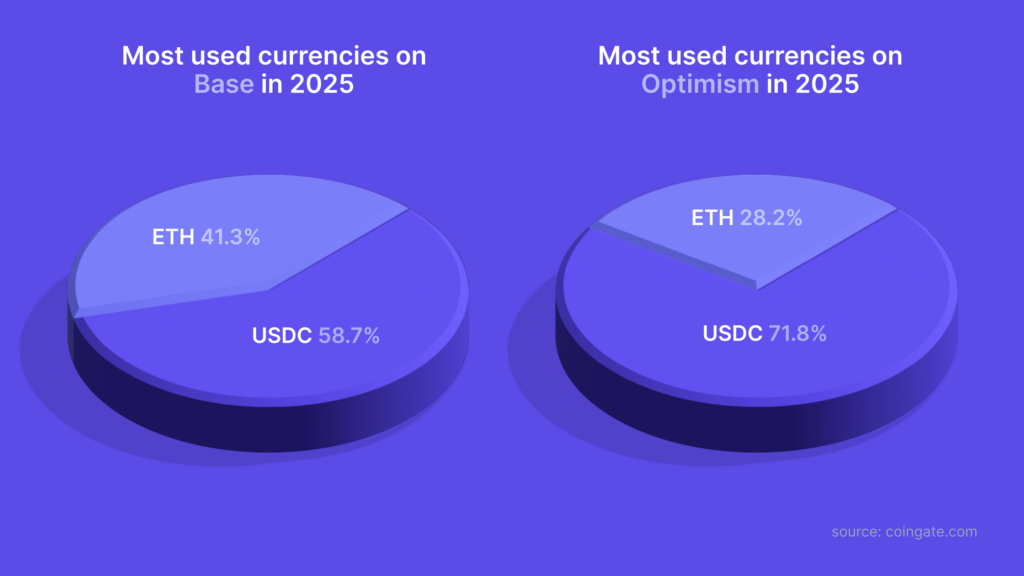
- Base: 58.7% of payments in USDC, 41.3% in ETH.
- Optimism: 71.8% of payments in USDC, 28.2% in ETH.
- Adoption pace: Base reached top 10 in just half a year; Optimism peaked at 13th.
- Markets: The U.S. dominates Base with 33% of usage, while Optimism shows diversity with traction in China, India, Nigeria, and the U.K.
Global Demand: The U.S. and Beyond
Geography adds another layer to the story. In every case, the United States is the single largest market for Layer 2 payments — sometimes by a wide margin. On Base, for example, nearly one in three payments comes from the U.S., an adoption level that dwarfs any other network.
But the picture isn’t limited to the U.S. Emerging markets like India, Nigeria, and Egypt consistently rank among the top users of Polygon and Arbitrum. In Europe, Germany, the Netherlands, and the U.K. show strong adoption. Asia also leaves its mark: Japan, Hong Kong, China, and Singapore all appear in the top lists for at least one Layer 2.
This global distribution suggests that L2 adoption isn’t just about cheaper transactions. In the U.S. it’s often about convenience and ecosystem strength, while in the Global South it’s about access to stablecoins as a financial lifeline.
Highlights:
- U.S. market share: 13.4% of Polygon, 19.6% of Arbitrum, 33% of Base, and 7.1% of Optimism.
- Emerging markets: India, Nigeria, Egypt, and Bangladesh consistently appear in the top lists.
- Europe: Germany, Netherlands, U.K., and France are strong adopters.
- Asia: Japan, Hong Kong, China, and Singapore also rank highly.
Explore a more in-depth look at regional trends of crypto payments.
From ETH to Stablecoins: The New Reality
Looking across all Layer 2 networks, one conclusion stands out: the era of ETH dominance in payments is over.
On Arbitrum, ETH’s collapse is dramatic, going from the majority of payments to less than a quarter in just two years. On Base and Optimism, ETH never even had a chance; USDC was the default from day one.
On Polygon, USDT and POL were the primary drivers at first — but in recent years USDC has grown so much that together, stablecoins now account for more than 70% of transactions.
Layer 2 networks were meant to make ETH transactions cheaper. Instead, they’ve become the infrastructure for stablecoin commerce.
Conclusion
Layer 2 networks may have started as Ethereum’s scaling experiment, but their real legacy is becoming something different. They are now the stablecoin rails of the digital economy — platforms where USDC and USDT move faster, cheaper, and more reliably than anywhere else.
Polygon and Arbitrum have matured into mid-tier giants, while Base and Optimism are proving that the next wave of growth will be even more stablecoin-heavy. The U.S. leads the charge, but adoption is spread widely across Europe, Asia, and the Global South.
In short, Layer 2 is no longer about saving ETH. It’s about powering stablecoins — and with them, the future of global payments.
Accept crypto with CoinGate
Accept crypto with confidence using everything you need in one platform.

